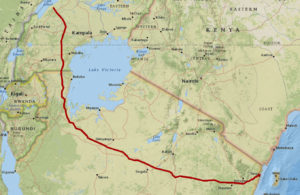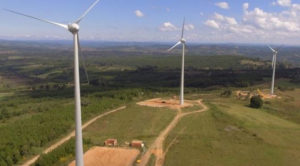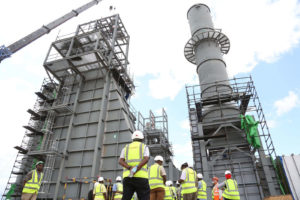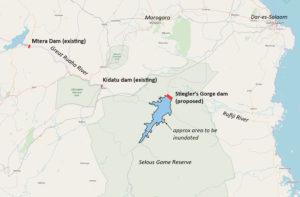by Ben Taylor
Note: we are seeking a new contributor to take over this section of Tanzanian Affairs. If you are interested, please contact the editor.
Tanzania-Uganda oil pipeline agreements signed
Uganda, Tanzania and the oil companies Total SE and China National Offshore Oil Company (CNOOC) signed three key agreements on April 11, 2021 in Uganda that pave the way for construction to start on the planned east African crude oil pipeline (EACOP). Both President Yoweri Museveni of Uganda and President Samia Suluhu Hassan of Tanzania were present to witness the signing of the agreements.
The 1,443km pipeline will transport crude oil from oil fields near Lake Albert in western Uganda to Chongoleani terminal in Tanga on the Tanzanian coast. From Lake Albert, the pipeline will head southwards, crossing into Tanzania near Bukoba and passing to the west of Lake Victoria before heading west to Tanga via Kahama, Singida and Kondoa. On completion, it is expected to be the world’s longest electrically heated pipeline. Uganda’s crude oil is highly viscous, so it must be heated to be kept liquid enough to flow.
Patrick Pouyanne, chief executive of the French oil giant Total, described this as a “momentous occasion in history … Expect the first oil tanker to dock at Tanga port in early 2025.”
The project is expected to cost at least USD $3.8bn, 80% of which will be spent in Tanzania. The full amount will be pooled through the EACOP holding company co-owned by the oil companies – Total E&P and China National Offshore Oil Company (CNOOC), and the governments of Uganda and Tanzania through their respective national oil companies, UNOC and TPDC. The transit tariff per barrel of crude oil going through the pipeline is to be capped at $12.77, after tax concessions were offered by the Tanzanian government.
President Museveni explained that he chose the date for signing the agreements as April 11th for sentimental reasons: to coincide with the toppling of former President Idi Amin by Ugandan rebel groups with the help of Tanzanian troops 42 years earlier on the same date. “So today is a triple victory for Uganda and Tanzania; militarily, politically, add economically,” he said. The event had been planned for March 22nd, but had been delayed out of respect for the late President Magufuli.
Environmental groups have expressed concern with the plans. A letter signed by 38 civil society organisations across both east African countries said the parties had failed to address environmental concerns over the pipeline and had steamrollered over court and parliamentary processes.
Diana Nabiruma, of the Africa Institute for Energy Governance (AFIEGO), told the (UK) Guardian newspaper: “It is concerning that major agreements are being signed and the companies are being given the go-ahead to award contracts and start developing the Lake Albert oil project. The projects pose major environmental risks. Resources, some shared with countries such as the DRC, Tanzania and Kenya, including Lake Albert as well as Lake Victoria and rivers, are at risk of oil pollution,” she said.
The #StopEACOP alliance campaign condemned the decision to build the pipeline, which it says will displace 12,000 families and would be a huge environmental risk at a time of climate emergency, when the world needs to move away from fossil fuels.
Vanessa Nakate, founder of the Rise Up climate movement in Uganda, said: “There is no reason for Total to engage in oil exploration and the construction of the east Africa crude oil pipeline because this means fuelling the destruction of the planet and worsening the already existing climate disasters in the most affected areas. There is no future in the fossil fuel industry and we cannot drink oil. We demand Total to rise up for the people and the planet,” she said.
David Pred, of Inclusive Development International, which supports communities to defend their rights against harmful corporate projects, said: “The oil companies are trying to dress up the investment decision signing ceremony, but fortunately this climate-destroying project is far from a done deal. Total and CNOOC still need to secure insurance and raise $2.5bn in debt financing for the EACOP to move forward and they are going to struggle mightily to find enough banks and insurance providers willing to associate themselves with such a project,” he claimed.
President Samia Suluhu Hassan commits to speed up LNG project
Among the many topics covered by the new President, she stressed the need to speed up the long-planned (and much-delayed) Liquid Natural Gas (LNG) processing plant on the southern Tanzania coast. The project cost is estimated at USD $30bn.
In two major speeches – on April 6 at a ceremony to swear-in new Permanent Secretaries and other officials, and April 22 in her maiden speech to parliament as President – she directed the Ministry of Energy to speed up the project by bringing in investors who are ready to start its implementation.
The LNG project has been stalled for some time now following the government’s decision to review Production Sharing Agreements (PSAs). Host Government Agreement (HGA) negotiations have been on and off, after they initially stopped in 2017 due to technicalities and resumed in 2018 only to stall again.
“We have been singing the LNG song for a very long time, I remember when I was sworn in as the Vice President I tried to work on it, but discovered it was beyond me and stopped,” she said. She stressed that it was time to understand who is in and who is out in the implementation of the project so that it can move forward. “We should do what we did when we decided to start construction of the Standard Gauge Railway (SGR) and we all saw how they came back seeking to be put on board,” she said.
There are a number of complicating factors to deal with in kick-starting the project. In addition to maximising the benefits to local communities and national revenue, negotiations will be affected by global gas price projections and the security situation in northern Mozambique.
Barrick Gold CEO praises President Magufuli
The president and chief executive of Barrick Gold Corporation, Mark Bristow, said the company mourned with the people of Tanzania at the loss of President John Magufuli.
Bristow described the late president as “a visionary statesman” who saw the value of a thriving mining sector to his country’s economy. He praised the late President for partnering with Barrick in a joint venture, Twiga Minerals Corporation, to manage the company’s mines in Tanzania and to share the economic benefits they generated equally. Bristow said Twiga would stand as a monument to President Magufuli’s foresight and should serve as a model for future partnerships between governments and mining companies in Africa.
The joint venture came after several years of a strained relationship between the government of Tanzania and Acacia, a company majority owned by Barrick and operating gold mines in Tanzania. President Magufuli accused Acacia of “stealing” by failing to pay proper taxes and exporting more gold than declared, and slapped the company with a USD $190bn tax bill. Protracted negotiations led to a compromise with Barrick offering a goodwill gesture to Tanzania of $300m, and establishment of Twiga Minerals as a joint venture.
Anti-smuggling measures at Mererani Tanzanite Mines declared ineffective
President Samia Suluhu Hassan noted new tactics of smuggling Tanzanite at the Mererani mines in Simanjiro District, Manyara region, and demanded security reinforcement to curb the malpractice. Previously, President Magufuli had overseen the construction of a perimeter wall surrounding the mines in an effort to reduce loses.
In her speech at the State House in Dar es Salaam on April 6, she said smugglers have now resorted to digging underground channels through which they have been sneaking Tanzanite past the 24.5km perimeter wall. As a result, she said, the stones are escaping just as before. “We have TPDF (Tanzania People’s Defence Forces) soldiers protecting the mineral site yet Tanzanite finds its way out of the fortified place,” said the President. She expressed her dismay over the trend, calling on the Ministry of Minerals to further reinforce security despite a successful installation of 24-hour surveillance CCTV cameras on the perimeter wall.




